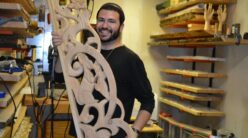Eduardo Schvartz*
Simone Schvartz**
- Introduction
The presence of Jews in Brazil dates back to the 15th-century during the persecution and discrimination by the Inquisition, many of them so-called “New Christians” who converted to Christianity but continued to practice their Jewish faith secretly. In the mid-17th century, when the Netherlands invaded and occupied the northeast of Brazil, a larger wave of Jewish migration arrived (1). In the early nineteenth century, many Jews migrated to Brazil due to the opening of seaports in 1808. During the reign of Emperor Dom Pedro II (1825-1891), Jews contributed considerably to the development of Brazil, especially in the areas of finance, culture and politics (2).
During the First World War and later during the Russian Revolution, there were between 5.000 and 7.000 Jews in the country. In the 1920s and 30s, the number increased to 30,000, due to a significant migration wave from Poland and the Soviet Union, where pogroms were taking place. The period of the Second World War and the Holocaust witnessed a significant migration and this number increased to 80.000 Jews in Brazil. In the post-war period, a relevant number of Mizrahi Jews migrated to the country (1).
Consequently, several waves of Jewish immigration over the centuries formed the Brazilian Jewish community. Different immigrants from different parts of the world and during different periods reached different areas of Brazilian territory. The Brazilian Jewish community is formed in its majority by Ashkenazi Jews who are mostly from Europe, in particular from Germany and Poland, followed by a significant number of Portuguese and Spanish descendants. Mizrahi Jews from Africa, especially Egypt and Morocco (1) compose another part of the Brazilian Jewish community. In fact, Brazil’s Jewish community of the 21st century is mainly the result of an immigration wave that began in the 19th century and intensified during the 20th century, reaching its peak between the years of 1926 and 1942 (3).
Currently, the Jewish Confederation of Brazil – CONIB (3) estimates that Brazil, South America’s largest country, is home to approximately 120,000 Jews, concentrated mainly in the states of São Paulo and Rio de Janeiro. There are also important communities in the states of Rio Grande do Sul, Minas Gerais, Pernambuco and Paraná. The first synagogue in the Americas, the Kahal Zur Israel, opened in 1636 in Recife, Pernambuco, during the period of Dutch control (1630-1654). It is worth mentioning that Brazil is home to the second biggest Jewish community in South America after Argentina, and the tenth largest Jewish community in the world.
Jews originating from different parts of the world brought their traditions, habits and culture to Brazil (3,4). Similar to other countries, the Jewish community in Brazil is organized in urban areas, most of them around institutions like synagogues, schools, athletic associations, charity institutions, among others, especially in Bom Retiro, a neighborhood in São Paulo, because of its proximity to the railway (4). In 1912, Bessarabian immigrants founded the Kehilat Israel Synagogue, the oldest Jewish house of worship in São Paulo. The Bom Retiro community blossomed between the 1920s and 1960s and the place is still known as the city’s historically Jewish-populated neighborhood (5).
2. The Memorial of Jewish Immigration and of the Holocaust in São Paulo
The Memorial da Imigração Judaica e do Holocausto (The Memorial of Jewish Immigration and the Holocaust in English) was inaugurated on February 2016 in the building of the Kehilat Israel Synagogue, in Bom Retiro . It is the first museum dedicated to Jewish immigration in Brazil with the purpose to preserve the traditions of the Judaic community. The memorial is located near the State Gallery, the Portuguese Language Museum, Luz Park, Railway Station and other local institutions (5).
The Memorial of Jewish Immigration and the Holocaust in São Paulo has the mission to collect, to preserve, to research and to exhibit Jewish religious traditions, history, art and culture through exhibitions and social and educational activities, promoting the history of the Jewish people in Brazil and in the world (5).
The museum features a valuable collection donated by members of the community including documents, objects of historic and artistic interest, photographs, clothes and rare books with the purpose to narrate the history of the Jewish community in Brazil and the waves of Jewish immigration, especially to São Paulo. Interactive displays highlight the contribution of the Jewish community to the development of Brazil over the past centuries.
The basement floor houses the significant contribution of the Jewish community to life in Brazil.
Picture 2 – Contribution of the Jewish community to life in Brazil (photos were kindly provided by the Memorial da Imigração Judaica e do Holocausto)

The ground floor houses the restored synagogue and the documents detailing its development. Currently, the synagogue retains its original features and is fully restored. The Bimá (central table), where the Torah is read, is original. The glass windows and the crystal chandeliers were very popular in the early twentieth century (2).
Picture 3 – Kehilat Israel Synagogue (photos were kindly provided by the Memorial da Imigração Judaica e do Holocausto)
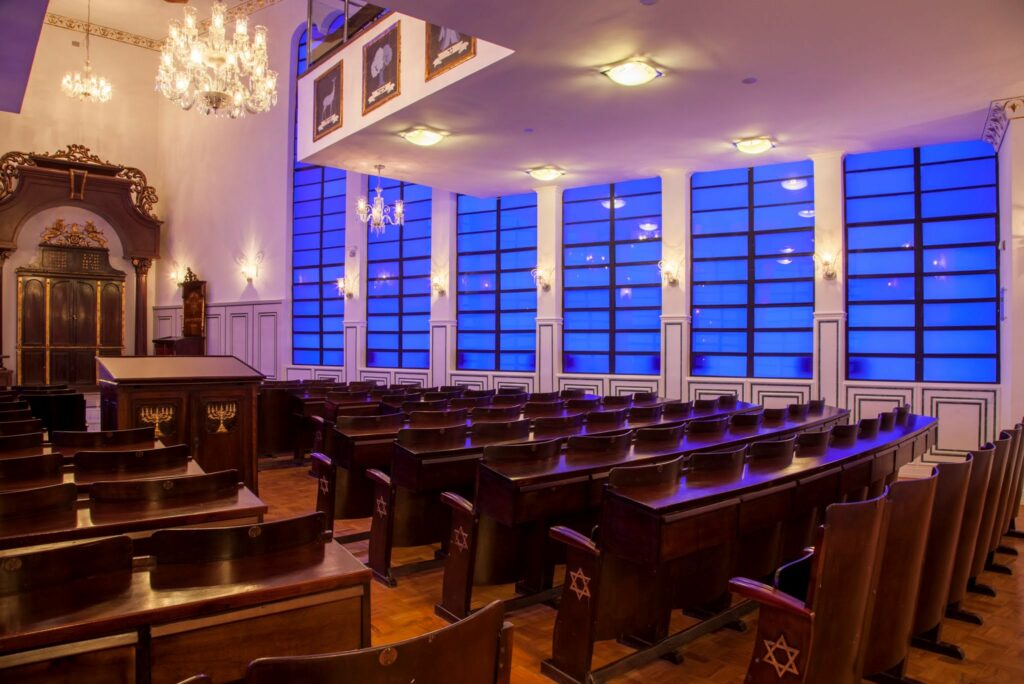
On the second floor, visitors can immerse themselves in experiences of Jewish traditions, especially in cultural, religious and historical aspects. Among the objects exhibited, there is a Shabbat candleholder from Nuremberg from 1798 and Chanukah candleholders from both the 18th and 19th centuries. The oldest object in the Memorial is a book titled “Dialoghi d’Amore”, by Juda Leon Abravanel, published post mortem in Venice in the year 1558 (2).
Objects brought in by Jewish immigrants portray the “Jewish lifecycle” and the rites of passage of Judaism (birth, adulthood, marriage and burial), traditions and cuisine by region. A gastronomic table demonstrates the typical dishes of Jewish cuisine consumed on Shabbat, Rosh Hashanah and Passover where visitors can discover curiosities of Ashkenazi and Sephardic cuisine (2).
Still on the second floor, there is a gallery with photographs of migrants’ families; they depict family gatherings, sports, festivities and celebrations (2).
Picture 4 – Photographs of families of Jewish immigrants (photos were kindly provided by the Memorial da Imigração Judaica e do Holocausto)

On the third floor, the Holocaust Memorial, inaugurated in November of 2017, introduces visitors to the different periods of the greatest Jewish catastrophe between 1933 and 1945, when the Nazi murdered six millions of Jews in an orchestrated, cruel and systematic manner.
With an interactive and audiovisual collection, the Holocaust Memorial features photos, objects, film footage, survivor testimony, maps, music, propaganda and personal stories of one of the darkest periods of human history that killed millions of Jews in Europe during the Second World War.
The Memorial is divided into eight parts, seeking an historical and chronological immersion in the suffering of the Jewish people, featuring Hitler´s ascension, the “boycott” imposed on Jews by the Third Reich, the atrocities of the Holocaust and liberation by the Allies.
The entrance to the Holocaust Museum is symbolic. To enter, visitors must cross the gates of the Auschwitz extermination camp, where there is a replica of the metal inscription “Arbeit Macht Frei”.
Picture 5 – Entrance of The Holocaust Memorial (photos were kindly provided by the Memorial da Imigração Judaica e do Holocausto)
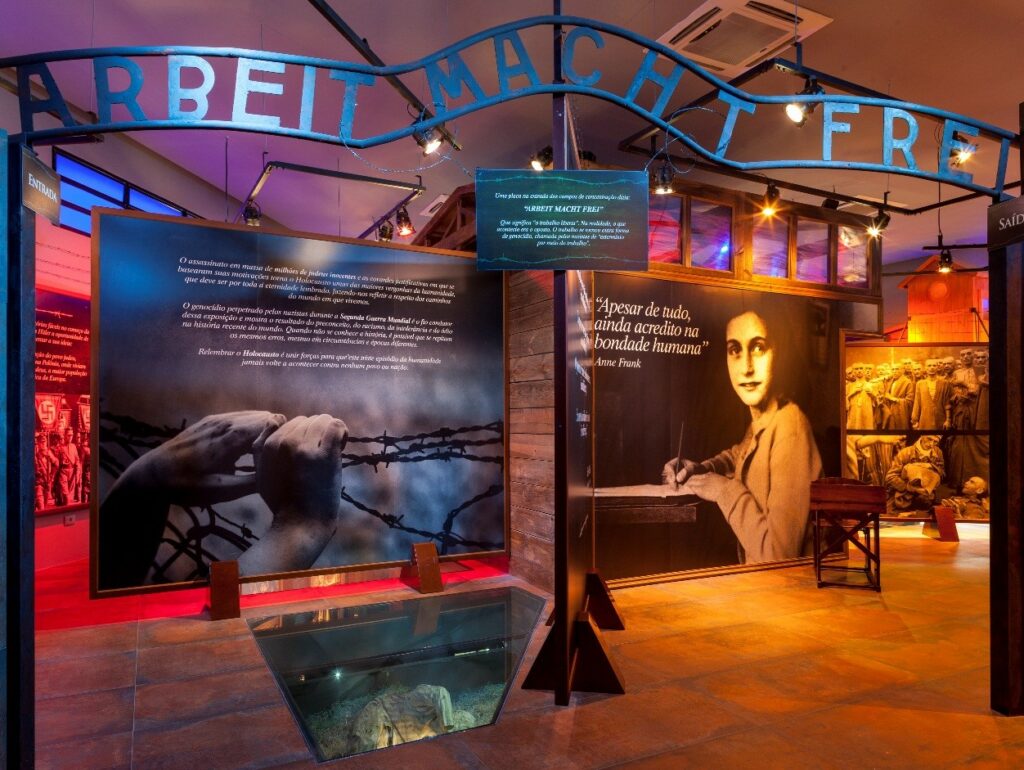
The first part of the Memorial allows visitors to reflect on the terms “Genocide” and “Holocaust” and the difference between these terms. In the next part, the impact of Nazi propaganda on the dissemination of anti-Semitic ideas.
In the following parts, visitors have a chance to face the horrors of anti-Semitism and the Holocaust from a unique Jewish perspective: the Kristallnacht, the “boycott” imposed on Jews by the Third Reich, “confinement in ghettos,” the mass killings perpetrated by death squads and the “Final Solution”, thought by the Nazi leadership at the “Wannsee Conference” in January 1942. In addition, visitors can understand more about the life in concentration camps and immerse themselves in a past that should never be revived.
The Memorial also features the close relationship between robbery by Nazis and their allies and the Holocaust. Legal decrees and administrative measures excluded Jews from the economy and Nazi seized their property and valuable objects. However, more than that, robbery by Nazis accelerated the progression from pogroms and ghettos to mass killing.
Picture 6 – Nazi´s Treasures (photos were kindly provided by the Memorial da Imigração Judaica e do Holocausto)
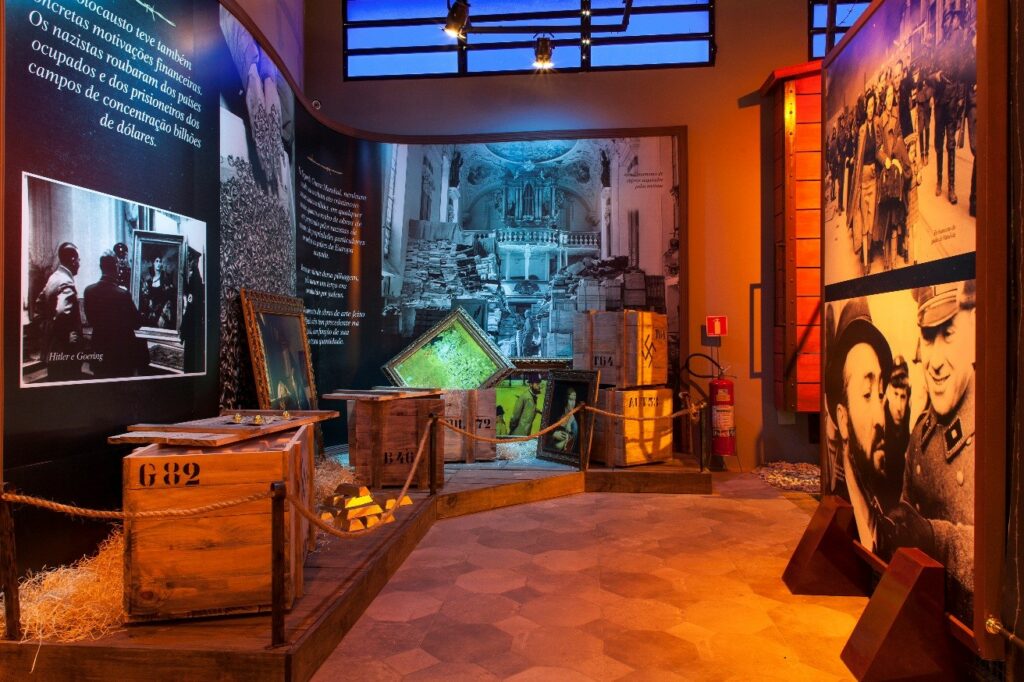
At the end of the tour, visitors can watch videos produced by the Nazis and allies, in Germany, in the Ghettos and in concentration camps.
The memorial not only recalls the atrocity that murdered millions of people but also honors Brazilians who saved Jews from imprisonment and death, as Luiz Martins de Souza Dantas and Aracy de Carvalho Guimarães Rosa, whose names are engraved in the Garden of the Righteous among the Nations, at Yad Vashem in Israel.
Dantas served as Brazil’s ambassador in France during the Nazi occupation of Europe. In 1940, Dantas requested and received permission from the Brazilian foreign minister to issue immigration visas to a limited number of French citizens. Despite Brazil’s ban regarding immigration of Jews, he granted diplomatic visas to hundreds of Jewish immigrants. Although Dantas was aware of the illegality of his actions, he intervened to save a passenger ship, the Alsina, carrying a large number of Jews. Dantas arranged the renewal of the then-expired visas, consequently enabling Jews to escape to Rio de Janeiro (6).
Aracy de Carvalho Guimarães Rosa worked as the Chief of the Passport Section in the Brazilian Consulate in Hamburg, Germany. Known as the Angel of Hamburg, she started to help Jewish people during the Kristallnacht and saved a great number of Jews from imprisonment and death (7).
3. Impressions
The Memorial, the first in Brazil dedicated to Jewish immigration, aims to preserve the memory of the Jewish people and to present to the public the arrival of Jews in Brazil from the colonial period to other periods of national history, including an entire floor dedicated to the Holocaust Memorial.
The center surprises by the human and pedagogical treatment given to its collection. Religious, historical and cultural themes are presented in an attractive and interactive way, which enriches the visitor’s relationship with the Jewish history. In addition, the Memorial values the educational approach since it offers monitored visits to schools, institutions and visitors.
The experience inside the Holocaust Memorial is remarkable. The atmosphere is sad but could not be different. We had the opportunity to analyze important questions chronologically regarding the measures Nazis took to isolate the Jewish community from the rest of the population. Hundreds of discriminatory laws and decrees against the Jews were passed. Jewish passports were invalidated and consequently they faced obstacles to both emigration and immigration. The occurrence of Kristallnacht—the “Night of Broken Glass” and why it is identified as a “turning point” in history. In addition, the identification badges in the form of a yellow star that Jews were forced to wear, the creation of ghettos to isolate and contain Jewish population and finally deportations to Death Camps.
Picture 7 – Horrors of Anti-Semitism (photos were kindly provided by the Memorial da Imigração Judaica e do Holocausto)
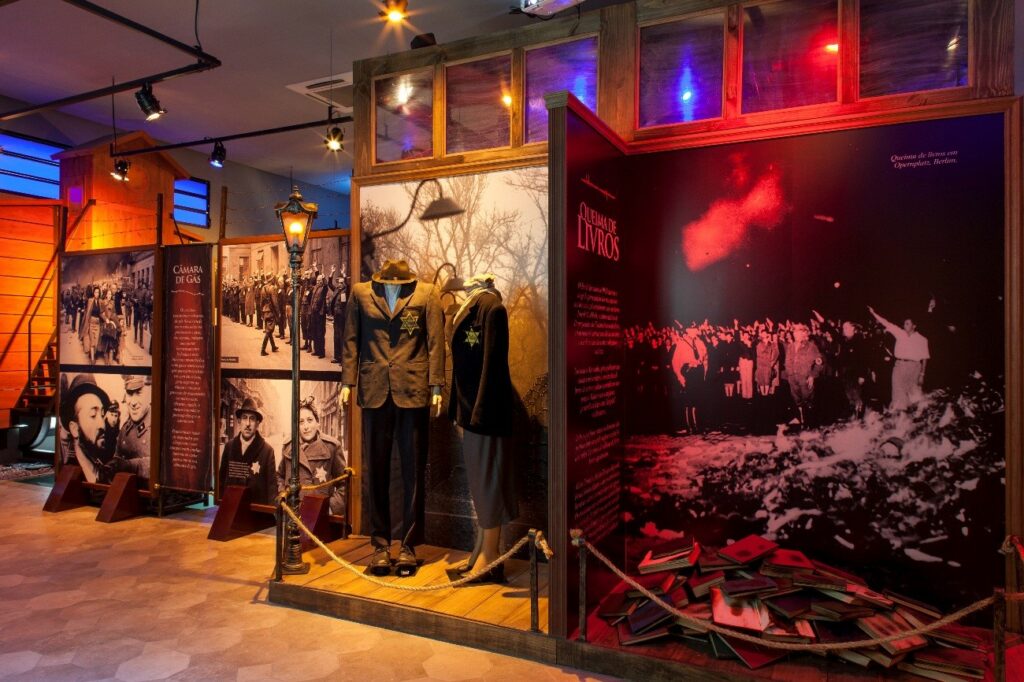
Therefore, the Holocaust Memorial is a place of contemplation, a place of remembrance, a place of reflection. As we walked through the Holocaust Memorial, we asked ourselves “How could anyone have done this?”, “Why did no one stop them?” “How did an ordinary Polish town became Auschwitz, the most significant Nazi site of the Holocaust?”, “What “liberation” meant to the survivors?” We cannot forget that, when World War II ended, although Jewish Survivors of the Holocaust were free, their homes were destroyed and many of their family members and friends had been killed.
Most importantly, the Holocaust Memorial inspires critical thought and personal growth, as it challenges visitors to think about what lessons they can learn from the Holocaust and how they can make a positive difference today and in the future. It is always crucial to remember that the Holocaust did not occur by accident, it occurred because individuals, associations and governments, indifferent to the suffering of others, chose to legalize discrimination, prejudice and ultimately, mass killing. In fact, Nazis targeted not only Jews but also diverse groups that they considered racial, biological, political, or social threats to society.
4. Conclusions
We can describe our visit to the Memorial da Imigração Judaica e do Holocausto as an engaging journey through the history, culture and traditions of the Jewish community in the world and in Brazil. The memorial plays an important role representing the Brazilian Jewish community in several different aspects: art, literature, culinary, rites and traditions. It is a dynamic center dedicated to display Jewish history and to promote reflection not only for those who are from the Jewish community but also for those who are interested in Jewish culture and history.
More than anything, the memorial is a place where people connect the past with the present. We learned that each migratory wave left their mark in Brazil through objects, documents, traditions and rites, an important source of inspiration for the following generations. Our visit to the Memorial had led us to the conclusion that the Brazilian Jewish community is definitely an important part of Brazil’s society.
The Memorial da Imigração Judaica e do Holocausto can be described as a place that magnifies the relevance of passing memories from one generation to the next. The Memorial is crucial to safeguard the memory of the Holocaust and to preserve survivor’s voices. As memories are passed on to the next generation, it is possible to ensure that the Holocaust is never forgotten.
Finally, education is a key tool to demonstrate the danger of increasingly anti-Semitism, prejudice and discrimination in the world. The Memorial da Imigração Judaica e do Holocausto creates opportunities to allow visitors to reflect on their role as global citizens, therefore helping to protect the multi-cultural society in which we live.
The authors would like to thank the Memorial da Imigração Judaica e do Holocausto, in particular Professor Reuven Faingold, Professor Ilana Iglicky and Michelle Marchtein who provided educational material, photos and helpful comments.
5. Memorial of Jewish Immigration (Memorial de Imigração Judaica)
For more information, please visit the website http://memij.com.br/index.php
Rua da Graça, 160 – Bom Retiro – S. Paulo/Brazil
CEP 01125-000Tel .: (11) 3331-4507
Sunday: only for scheduled groups.
Monday to Thursday: 9am – 5pm.
Friday: 9 a.m. – 3 p.m.Admission: Free
6.References
1. Fernandes, Daniella Kohnen Abramovay. The Complex Relationship between the Brazilian Jewish Community and Israel. The Jewish Institutions and Their Leadership in São Paulo. University of Leiden, MA International Relations. MA Thesis.
2. Memorial da Imigração Judaica e do Holocausto. Catálogo, 2019. Kindly provided by the Memorial da Imigração Judaica e do Holocausto.
3. CONIB. Accessed May 2nd , 2019. http://www.conib.org.br/historia
4. Decol, René Daniel. JUDEUS NO BRASIL: explorando os dados censitários. REVISTA BRASILEIRA DE CIÊNCIAS SOCIAIS – VOL. 16 nº 46, Junho/2001.
5. Memorial de Imigração Judaica de São Paulo. Accessed May 2nd, 2019. http://memij.com.br/index.php/historico/o-memorial
6. Koifman, Fabio. Quixote nas Trevas – o embaixador Souza Dantas e os refugiados do Nazismo, 2002, 1ª edição, Editora Record.
7. Haag, Carlos. A Guerra dos Rosas, PESQUISA FAPESP, edição 189, novembro de 2011, pág. 82-87.
7.Museum Review
*Eduardo Schvartz is a Brazilian jewelry designer. He has a Bachelor’s Degree in Design in Brazil (Faculdade da Cidade University). Shortly after starting his graduation, a project called UniversidArt selected his Fabergé-inspired jewel to be exhibited at the Brazilian National Museum of Fine Arts. Later, he designed a ring named Arcos da Lapa commissioned to an official Brazilian event to celebrate Rio de Janeiro City. Throughout his career, he has attended several courses on Gemology and Design. Eduardo shares his artwork through social media pages on Instagram and Facebook.
Instagram: @eduschwart
Facebook: Eduschwart
Email: [email protected]
** Simone Schvartz works as a civil servant in the Brazilian Government since 2005. She has post-graduation degree in Public Policies (Candido Mendes University) and MSC in Administration in Health Systems (Oswaldo Cruz Foundation – National School of Public Health).


